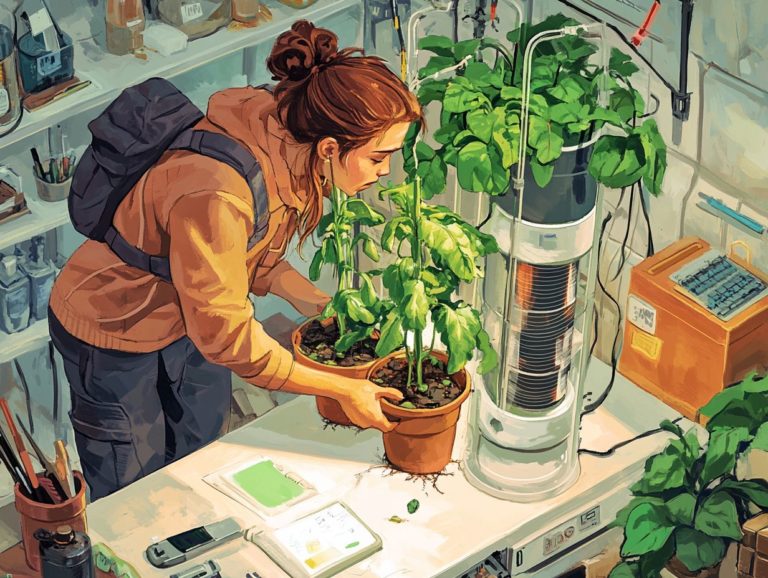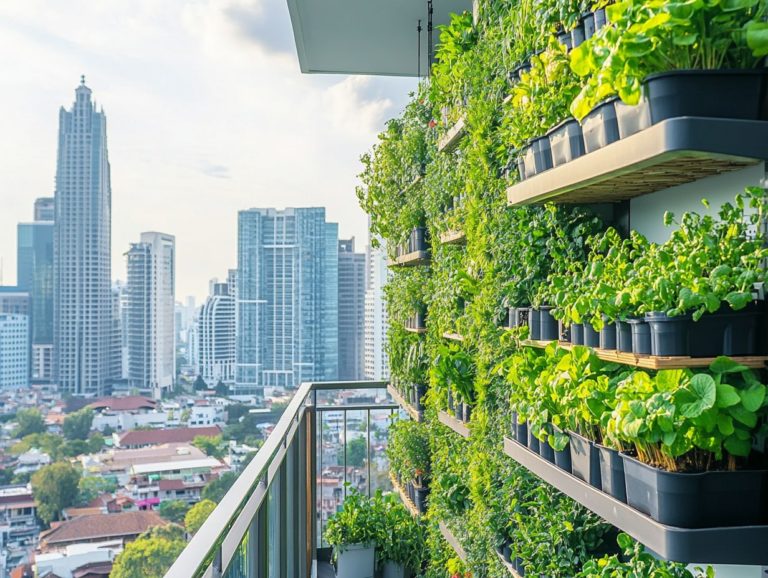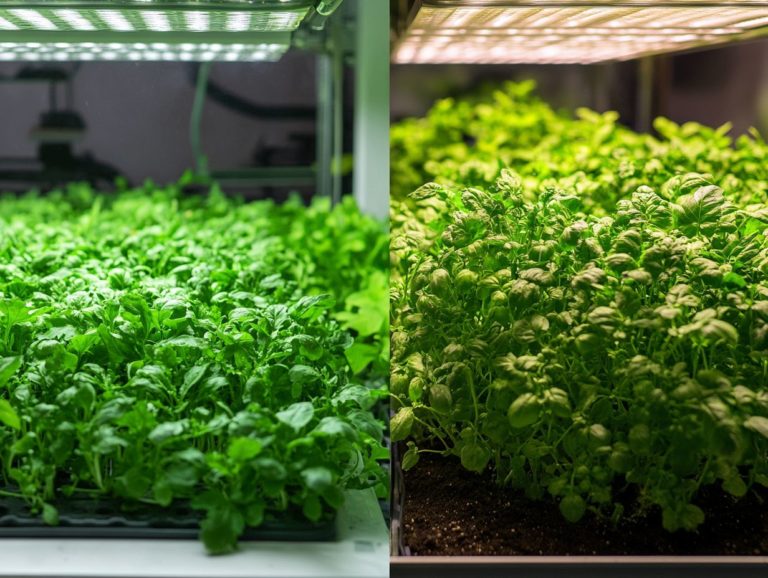How to Monitor Hydroponic Plant Health?
Get ready to explore how hydroponics is revolutionizing the gardening landscape! Hydroponics enables plants to flourish without the need for soil, presenting a sustainable alternative that urban dwellers and gardening enthusiasts alike can embrace.
In this article, you will uncover the myriad benefits of hydroponic gardening, highlighting its advantages over traditional methods. You ll learn to identify the signs of healthy plants and troubleshoot common issues while discovering effective monitoring techniques and preventive measures to ensure your hydroponic garden thrives.
Join us as you delve into the intricacies of succeeding in this innovative growing system!
Contents
- Key Takeaways:
- Benefits of Hydroponic Gardening
- Signs of Healthy Hydroponic Plants
- Common Problems in Hydroponic Plants
- Monitoring Techniques for Hydroponic Plants
- Tools and Methods for Tracking Plant Health
- Preventive Measures for Maintaining Plant Health
- Tips for Avoiding Common Problems
- Frequently Asked Questions
Key Takeaways:

- Monitor your plants regularly to identify any potential issues in your hydroponic garden using a systematic approach for maintenance.
- Utilize tools and techniques, like pH meters and nutrient sensors, to track the health of your hydroponic plants accurately.
- Take preventive measures, such as maintaining proper pH and nutrient levels, to ensure the overall health and vitality of your hydroponic plants.
What is Hydroponics?
Hydroponics is a modern way to grow plants without soil. This method utilizes a nutrient-rich liquid solution to deliver essential nutrients directly to the roots. It allows for precise control over water quality, pH levels, and nutrient solutions, significantly enhancing plant health and growth rates compared to traditional soil gardening, making it ideal for smart hydroponics.
By employing systems like nutrient film technique (NFT, a method that delivers nutrients in a thin film of water) or deep water culture (DWC, which involves growing plants in oxygenated water), hydroponics not only stabilizes your system but also maximizes space efficiency, making it a perfect choice for urban farming.
This technology reduces water usage and minimizes the risk of pests and soil-borne diseases, leading to healthier crop yields. As you embrace hydroponics, you can optimize growth cycles and tailor your nutrient management practices to meet specific plant requirements through extensive monitoring. If you encounter challenges, learning how to troubleshoot common hydroponics issues can boost overall productivity.
With ongoing advancements in agricultural technology, hydroponics is set to play a crucial role in sustainable farming. It offers an exciting solution for future food security through the integration of IoT technology and smart monitoring systems.
Benefits of Hydroponic Gardening
Hydroponic gardening presents a wealth of advantages over traditional soil gardening. You can expect faster crop production with the help of monitoring parameters, which means your harvests come in a timely manner.
The efficient use of water resources conserves this precious commodity while enhancing growth. The reduced risk of pests and diseases makes hydroponics a remarkably sustainable choice for modern agriculture, especially with the implementation of special nutrient formulas. Embracing this method positions you at the forefront of innovative farming practices.
Advantages over Traditional Soil Gardening
The advantages of hydroponics over traditional soil gardening are truly remarkable. By allowing for precise control of environmental conditions and monitoring systems, you can significantly minimize crop loss and enjoy quicker growth cycles.
Hydroponics is incredibly space-efficient, making it a perfect fit for urban dwellers with limited gardening space. Unlike traditional soil gardening, which often requires sprawling plots, hydroponic systems can flourish in compact environments through the use of automated processes, even indoors.
This innovative method not only reduces your reliance on pesticides, thanks to the contained growing systems, but it also ensures better resource management by delivering nutrients directly to the plants. As a result, you can achieve increased yields per square foot, demonstrating how this modern technique adapts seamlessly to various settings while championing sustainability.
Are you ready to start your hydroponic journey? Share your experiences in the comments below!
Signs of Healthy Hydroponic Plants

Identifying the signs of healthy hydroponic plants is essential for your gardening success. Look for indicators like vibrant leaves, robust root systems, and consistent growth stages. These reflect optimal pH levels, effective nutrient uptake, and stable environmental conditions within your hydroponic system, supplemented by regular testing of water quality.
Visual Cues of Plant Health
Visual cues of plant health in hydroponics are crucial for your success. Look for indicators like lush green foliage, strong stems, and an overall vigor, signaling a proper balance of nutrients and optimal environmental conditions.
The absence of issues such as yellowing leaves or too much fertilizer further emphasizes that your plants are thriving. To enhance your success, learn how to optimize hydroponic plant growth and make monitoring your plants a habit, watching them thrive!
Don’t overlook the roots; they are just as important. Healthy, white roots indicate a nutrient-rich environment, while brown or mushy roots may signal problems like root rot, often stemming from overwatering or poor aeration. To ensure your nutrient solution is effective, consider learning how to test your hydroponic nutrient solution. Both are affected by water level and temperature control.
By closely observing these visual cues, you can make timely adjustments to your hydroponic system, ensuring that your plants enjoy robust growth and vitality through proper nutrient additions and monitoring parameters. For more guidance, check out how to troubleshoot common hydroponic issues.
Common Problems in Hydroponic Plants
Common issues you may encounter in hydroponic plants typically arise from improper nutrient management, fluctuations in pH levels, and insufficient monitoring of environmental conditions. These problems are often exacerbated by ineffective cleaning of reservoir practices.
Act quickly! Ignoring these problems can lead to devastating crop loss, jeopardizing your efforts and investment in maintaining a clean system.
Identifying and Addressing Issues
Identifying and addressing issues in hydroponics demands your keen observation of plant symptoms, regular testing of water quality, and thoughtful adjustments to nutrient-rich liquid formulations. This helps maintain optimal growth conditions through effective monitoring systems.
These steps are essential for any hydroponic gardener aiming to foster healthy plant development. When your plants show signs of distress, like yellowing leaves or stunted growth, it’s crucial to dive into an investigation of the water parameters, such as pH and how well the water conducts electricity. For more detailed guidance, refer to this resource on how to troubleshoot hydroponic system failures. These factors play a significant role in nutrient uptake.
Taking corrective actions may involve fine-tuning the nutrient solution based on specific deficiencies revealed by the symptoms you observe. By systematically diagnosing issues and implementing steps for effective hydroponic troubleshooting, you can cultivate an environment where your plants not only survive but thrive, leading to abundant yields.
Monitoring Techniques for Hydroponic Plants

Effective monitoring techniques are crucial for your hydroponic plants. Consider utilizing advanced monitoring systems equipped with pH level indicators, temperature sensors, EC readings, and TDS sensors. Leverage the Blynk application for real-time data access.
These tools will help you create and maintain the optimal growing conditions your plants need to thrive while ensuring effective nutrient management.
Stay observant and proactive, and your hydroponic garden will reward you with a bountiful harvest!
Tools and Methods for Tracking Plant Health
Modern hydroponic systems equip you with sophisticated tools and methods to monitor plant health. By harnessing IoT technology, including sensor integration, you can collect real-time data on crucial factors such as nutrient levels, water quality, and environmental conditions.
These advanced systems feature specialized sensors and data logging devices, offering precise measurements of pH, temperature, and moisture levels. Utilizing cloud-based platforms, you can analyze this data quickly, enabling you to make informed decisions.
By integrating environmental monitoring tools like automated irrigation systems and nutrient dosing, you can optimize growth conditions effectively. This proactive approach enhances plant health and leads to improved yield and resource efficiency through systematic maintenance. Additionally, knowing how to test nutrient levels in hydroponics perfectly aligns with sustainable agricultural practices.
Preventive Measures for Maintaining Plant Health
Implementing preventive measures to maintain plant health is crucial for success. Regularly test your nutrient solutions and clean the reservoir to prevent disease.
Ensure that water levels and pH balance remain optimal throughout the growth cycle while consistently monitoring parameters.
By taking these proactive steps, you create an environment where your plants can thrive.
Tips for Avoiding Common Problems
To sidestep common challenges in hydroponic gardening, adopt strategies such as ensuring proper nutrient additions and using automated systems for monitoring key parameters.
Maintaining a stable growing environment with frequent data logging is essential. These practices promote robust plant health and enhance growth rates and yield quality.
A crucial aspect of managing nutrients involves regularly testing the pH and electrical conductivity of your solution. Fluctuations can lead to situations where plants can’t take in nutrients or deficiencies—something you definitely want to avoid. For more insights on this, check out understanding hydroponic system maintenance.
Incorporating beneficial microorganisms can improve nutrient uptake and bolster the overall resilience of your system. Consistent temperature and humidity levels are vital for minimizing stress on your plants, which can lead to disease if ignored.
Embrace these actionable tips to cultivate a thriving hydroponic ecosystem that effectively minimizes common pitfalls associated with plant cultivation. Act now to ensure your plants thrive!
Frequently Asked Questions

What is hydroponic plant health monitoring?
Hydroponic plant health monitoring is the process of regularly checking and tracking the health and well-being of plants grown in a hydroponic system. This involves growing plants in a nutrient-rich water solution instead of soil. This process often includes using a monitoring system that tracks pH levels, EC readings, and TDS measurements.
Why is it important to monitor hydroponic plant health?
Monitoring hydroponic plant health is crucial for ensuring optimal growth and yield. By regularly assessing plant health, growers can detect and address any issues before they become serious problems that could harm the plants or affect their production.
How do I monitor hydroponic plant health?
Monitor your hydroponic plants using several methods. Visual checks, pH tests, and nutrient measurements are key.
What are the signs of a healthy hydroponic plant?
Look for vibrant green leaves and strong stems. Healthy plants show consistent growth and no wilting.
What common issues affect hydroponic plant health?
Watch for improper nutrient balance, pH changes, poor lighting, pests, and diseases. Regular checks help you tackle these problems quickly.
How often should I monitor my hydroponic plant health?
Check your plants at least once a week to keep them thriving! Don’t wait until problems escalate monitor regularly!






